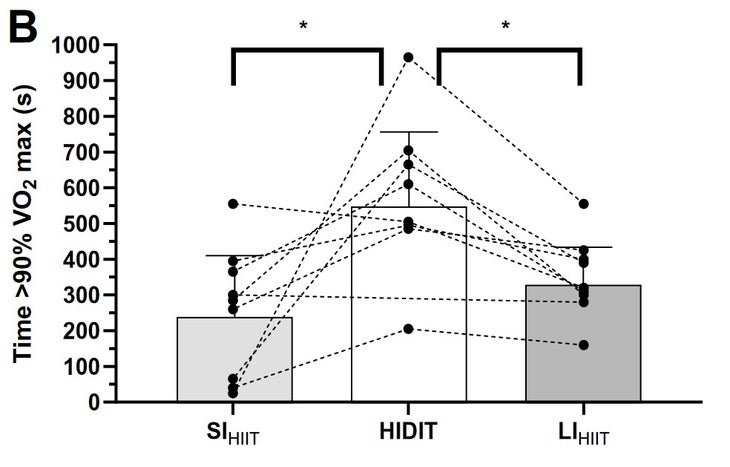For years now, I’ve had a default workout format that I rely on when I’m looking for a good hard effort that doesn’t feel that hard: the descending ladder. The details depend on how fit I am and what I’m training for, but a typical example would be 5:00, 4:00, 3:00, 2:00 (with recovery jogs lasting half the duration of the previous interval) and then 1:00 hard/1:00 easy for as many times as I feel like. There’s something about the mental and physical trajectory of these workouts that hits a sweet spot for me.
So a recent study by Filippo Vaccari and his colleagues at the University of Udine in Italy, , caught my eye. The study’s title talks about “optimizing oxygen consumption” and “the exponential reconstitution behaviour of D’,” but when you dig into the details, you realize it’s making a physiological argument for the magic of the descending ladder workout. Call it confirmation bias, but I find it pretty compelling.
The ideas in the paper rely on the concept of “critical speed,” which has been popping up in endurance-related research with growing frequency in recent years. Basically, it’s the threshold that separates sustainable from unsustainable efforts. Once you’re running faster than critical speed, the clock is ticking and you’ll soon hit exhaustion. How soon? That depends on your anaerobic capacity, sometimes referred to as D’, which is a sort of auxiliary gas tank that allows you to sustain paces above critical speed until it’s depleted.
The key point about anaerobic capacity is that it begins to recharge as soon as you drop below critical speed. This is the basic dynamic of interval workouts: you run hard to (almost) deplete your anaerobic capacity, then you jog or rest briefly to recharge, then you repeat ad nauseam (sometimes literally). In doing so, you’re able to accumulate far more time at a relatively high level of physiological distress than if you just ran hard with no recovery periods. (For a more technical discussion of anaerobic capacity in interval workouts, check out Philip Skiba’s recent book, .)
What makes ladder workouts special, according to Vaccari, is how anaerobic capacity recharges: the emptier the tank is, the faster it recharges in a given amount of time (that’s the “exponential reconstitution behavior” of the title). If you’re mildly tired, you’ll get a minor benefit: your anaerobic capacity might go from, say, 80 to 85 percent during a minute of recovery jogging. If you’re at the edge of exhaustion, in contrast, it might go from 10 percent to 50 percent in the same period of time. That means you get more bang for your recovery buck when you’re tired—and suggests that you should start your workout with longer hard intervals, then shift to shorter intervals with more frequent recovery as you get more fatigued.
Vaccari and his colleagues first tested their idea on cyclists in , and their new study extends it to runners. They started with a simple test to confirm that anaerobic capacity recharges more quickly when you’re tired. The subjects did three runs to exhaustion at a pace that they could normally sustain for about six minutes. In one trial, they got a two-minute break after 30 seconds. In the second trial, they got the same break after 3:00. And in the third trial, they ran to exhaustion, then got a two-minute break, then resumed running at the same speed until they reached exhaustion a second time.
The results were clear: the subjects reached exhaustion soonest (after 308 seconds of running) when they had a break after 30 seconds; had a medium result (388 seconds) with a break after three minutes; and lasted longest (464 seconds) when they ran all the way to exhaustion before taking their two-minute breather. In other words, the more tired they were when they took that break, the greater the benefit they got from it, presumably because they were able to recharge their anaerobic capacity at a higher rate.
How does this translate to full interval workouts? The researchers tested two common workout designs: long intervals (3:00 hard, 2:00 easy, repeated to exhaustion) and short intervals (30 seconds hard, 20 seconds easy, repeated to exhaustion). They compared them to a descending ladder with hard efforts of 3:00, 2:00, 1:00, 0:45, and then 0:30 repeated to exhaustion, with recovery jogs of two-thirds the duration of the previous hard interval. The idea is that you start with long intervals while your anaerobic capacity is fairly full, and gradually move to short intervals as it gets depleted, so that you’re always starting your recovery interval in a sufficiently fatigued state.
The results were, once again, impressive. Here’s a graph showing the total amount of time spent above 90 percent of VO2 max, which is a zone that’s thought to stimulate big fitness gains. On the left is short intervals (SI); in the middle is the ladder workout, which they call “high intensity decreasing interval training,” or HIDIT; on the right is long intervals (LI).

Even though all three workouts involved running to voluntary exhaustion, the runners spent nearly ten minutes (579 seconds) working at higher than 90 percent of VO2 max during the ladder workout, compared to roughly half that amount of time during the other two protocols. That’s a dramatic difference, driven mostly—but not entirely—by the fact that the subjects were able to keep churning out 30-second intervals at the end of the workout for longer than in the other protocols.
For me, that increase in time above 90 percent of VO2 max isn’t necessarily the selling point. It’s potentially useful if you’re looking for a real go-to-the-well sufferfest, but in practice I seldom do workouts to volitional exhaustion. Instead, I look at it the other way around: to accumulate the same amount of time above 90 percent as in the short or long interval workouts, I can stop the ladder workout well before exhaustion. I’ll get a similar physiological stimulus, but it’ll feel easier and put less wear-and-tear on my body.
There’s also a deeper philosophical question to wrestle with here. Is making workouts easier a good or a bad thing? It’s like the debate about wearing carbon-plated supershoes in training. Is it better to wear them and rack up faster workout times, or to avoid them and force yourself to work harder in training so that the race will be easier? There are good arguments either way, but the key for me is that I generally run my workouts based on effort rather than pace. That means I’m not looking for an easy way out: I push as hard as feels appropriate on that particular day, whatever workout I choose. Within those constraints, I’ve always felt that I get more out of myself in ladder workouts—and Vaccari’s data suggests I might not be crazy after all.
For more Sweat Science, join me on and , sign up for the , and check out my book .


